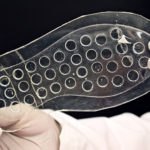 Diabetes is an increasingly common condition in western economies, and whilst attempts to both prevent and then manage the condition are improving, a recent study highlights the challenges that still exist when it comes to remission of foot ulcers resulting from diabetes.
Diabetes is an increasingly common condition in western economies, and whilst attempts to both prevent and then manage the condition are improving, a recent study highlights the challenges that still exist when it comes to remission of foot ulcers resulting from diabetes.
The study suggests that healthcare providers wrongly focus their efforts on repairing the tissue surrounding the ulcer, and thus healing the wound, when they should be focusing their attention on the remarkably high frequency of remissions. The authors suggest that roughly 1/3 of diabetics will develop a foot ulcer, which can have severe consequences.
What’s more, these ulcers can often emerge surreptitiously, with patients not noticing until it’s too late. This sadly results in up to 24% of diabetics in the United States ending up losing toes, a foot or a leg. New research from Purdue University suggests a new way of preventing this from happening.
“One of the ways to heal these wounds is by giving them oxygen,” the researchers explain. “We’ve created a system that gradually releases oxygen throughout the day so that a patient can have more mobility.”
Regaining sensation
Much of the problem related to diabetic ulcers is that the high blood sugar levels often damage the nerves in the feet and toes, which takes away their sense of feel. This in turn reduces our ability to detect pain, so bumps and bruises go unnoticed, and skin tissue breaks down. This ultimately leads to ulcers forming.
What’s more, the high levels of sugar in the bloodstream combine with the dried skin that often accompanies diabetes can slow the healing of any ulcers that do emerge.
“We typically treat ulcers by removing devitalized tissue from the surface of the wound, and by helping the patient to find ways to take the weight off the affected foot,” the team say. “The gold standard for treating an ulcer is a patient wearing a total-contact cast, which provides a protective environment for the foot. If we could test how well this insole delivers oxygen to the wound site from within the cast, then this could be a way of aiding the healing process.”
The Purdue team created a silicone-based rubber insert that can be injected into insoles. The device is designed to release oxygen specifically at the part of the foot where the ulcer is located.
Silicone was chosen because it’s flexible enough to work in a shoe insert, but also has good oxygen permeability qualities. The team used laser machining to tune this permeability to specifically target the wound area and therefore avoid exposing the healthy part of the foot to excessive oxygen.
Put to the test
The device was put to the test in laboratory conditions, and the team found that it was capable of delivering oxygen to the ulcerous area of the foot for around eight hours per day for people of average weight (it was effective at between 53-81kg, although the team claim this can be adjusted for heavier people).
The next step is to work with a manufacturer to bring the product to market, where the team envision a customized pack of insoles being sent to patients based upon specific wound profiles for that individual.
The team are working on a method of 3D printing the entire insole rather than doing it piecemeal with the mold first and then the oxygen releasing pattern.
“We’re wanting to bring this technology to the user by addressing whichever technicalities would be required to simplify the manufacturing flow,” they explain.
Such is the damage caused by diabetic ulcers, it’s a fascinating project that will hopefully make its way to market and bring relief to millions of people around the world.